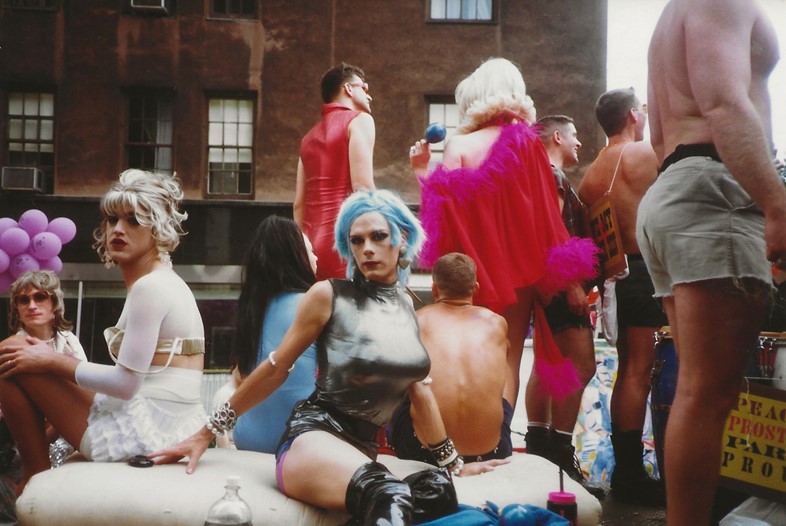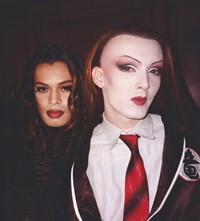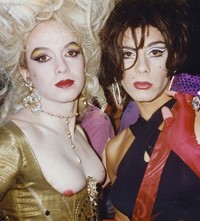The photos of ‘drag documentarian’ Linda Simpson have immortalised New York’s drag scene in the 1980s and 90s
- TextZooey Gleaves
You may not recognise Linda Simpson’s name, but you’ll have seen her pictures: the New York-based drag queen’s photographs have immortalised the rough decadence and vibrancy of downtown Manhattan in the 1980s and 90s. Armed only with a point-and-shoot camera, Simpson started taking pictures as a way to combat her shyness, using her camera as a way of immersing herself in New York, having move into a small apartment on East 13th Street in the late 80s. There, Simpson was perfectly situated to observe and interact with New York’s queer community first-hand: emceeing and promoting her weekly night Channel 69 at the Pyramid Club, Simpson hosted performers and fellow drag queens who would come to define downtown Manhattan’s queer scene (Tabboo!, Happyface, Sweetie, Mistress Formika and RuPaul were just some of the queens Simpson worked with and documented in her photos). Meanwhile, her magazine My Comrade would feature the performers, go-go dancers and politics of the time, and ran in the 90s, only to be revived in 2004.
By the mid-90s, the documentaries Wigstock: The Movie and Dragtime had been shown on TV nationwide, and Simpson was one of nine queens chosen to grace the cover of New York Magazine in a profile of drag in the city – 24 years before the multi-cover issue of the publication starring the queens of RuPaul’s Drag Race hit newsstands this year. Today, drag has entered the mainstream in a way that feels more permanent, and Simpson’s work as a photographer and ‘drag documentarian’ is more important than ever. “Drag, bottom line, is showbusiness,” she says. And while she welcomes the increasing attention on queens – and opportunities for them – she also says that drag’s presence could be more democratic, and not simply “ghettoised” on shows like RuPaul’s Drag Race.
As for Simpson’s own longevity, she explains: “I haven’t taken it too seriously; I’ve never pinned my hopes on massive success.” That said, her work is now getting the attention it deserves: with an exhibition at Tiger Strikes Asteroid being staged in May next year and another of My Comrade coming to Howl in January of 2021, the importance of her archive and legacy is undeniable. Here, Simpson shares the story behind her photographs from The Drag Explosion, a series of work shown as a slideshow set to music, which provides a comprehensive history of drag in New York.

“I was born in Minnesota, in the northern middle of the United States, and I moved to New York when I was quite young – I came for school and I’ve been here ever since. I really didn’t have that much logic for doing [photography], it was more just for fun. I think part of it was that I always had a journalistic quality and I liked documenting stuff, and part of it was that I was shy, and the camera was a way of approaching people.
“Like many queens, Halloween was the first time I dabbled in drag, but there was a gradual implementation of the Linda Simpson personality. I started out in the drag scene as more of an observer: the East Village scene in the mid-80s was a very interesting place to be, and I began to publish my magazine My Comrade, which was my entry into the scene. From there I became friends with Lady Bunny, Tabboo!, Happyface and Mistress Formika. I produced quite a few parties – clubs would contact me, and back then it was the glory days of the big clubs in New York, and there were a lot of opportunities, not just for me but other queens. Webster Hall was one of several large clubs back then that competed for crowds. There was The Limelight, The Tunnel, Roxy, Webster Hall, Palladium, and they were all able to hold thousands of people. So they hired drag queens and club kids galore to be go-go dancers and hosts and performers and door people. Sometimes all you had to do was host and just lounge around, but basically it was to get fabulous people in and the logic was that it would attract the masses.
“Pop culture really took an interest in drag in the 1990s. In The Drag Explosion, I trace this rise of drag from the East Village scene, spreading out to clubland-at-large and then the media and entertainment industry started picking up. Firstly it was music videos and avant-garde magazines and then when RuPaul hit it big with her first single Supermodel, that really generated a lot of interest in drag, especially the drag scene that Ru had come from [the downtown New York scene]. And so all of a sudden every daytime talk show, every magazine, every music video, movies, TV shows, et cetera, all wanted drag. It really became this pop culture phenomenon – with Ru getting the lion’s share of the attention and rightly so – and all of a sudden people were thrust into the public eye.
“The media lost interest in the end, and treated drag like a trend. There was no internet then of course, so you couldn’t keep your own momentum or personality going. Once the media had decreed that drag was over, that bubble burst, and the glory days, that drag explosion, ended. Drag really went on hiatus until Ru started Drag Race. There are so many drag queens now, some are of the moment, some are of the season, some are around for a few years and some are compelled to keep going – so we’ll see who stands the test of time.”















